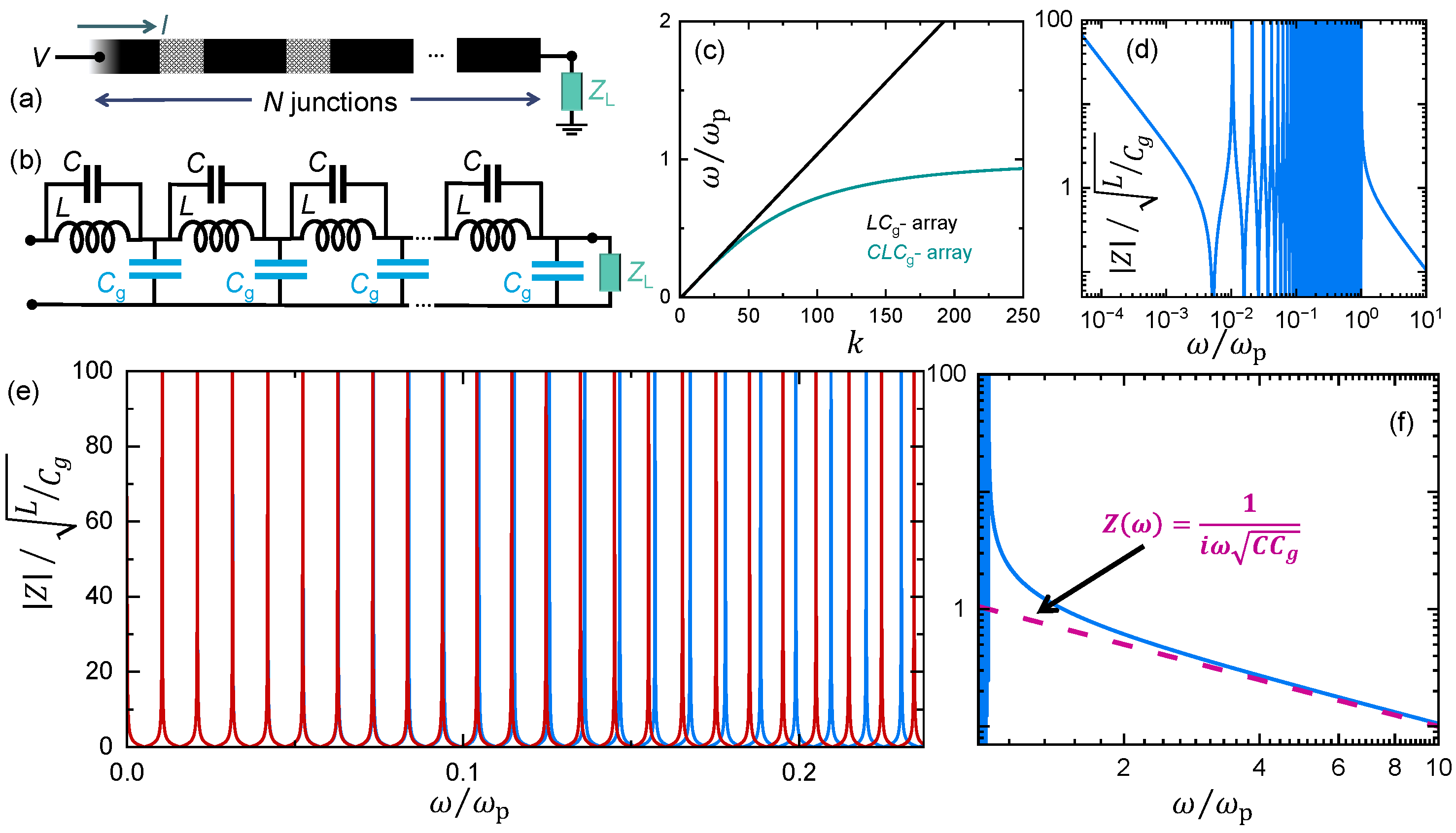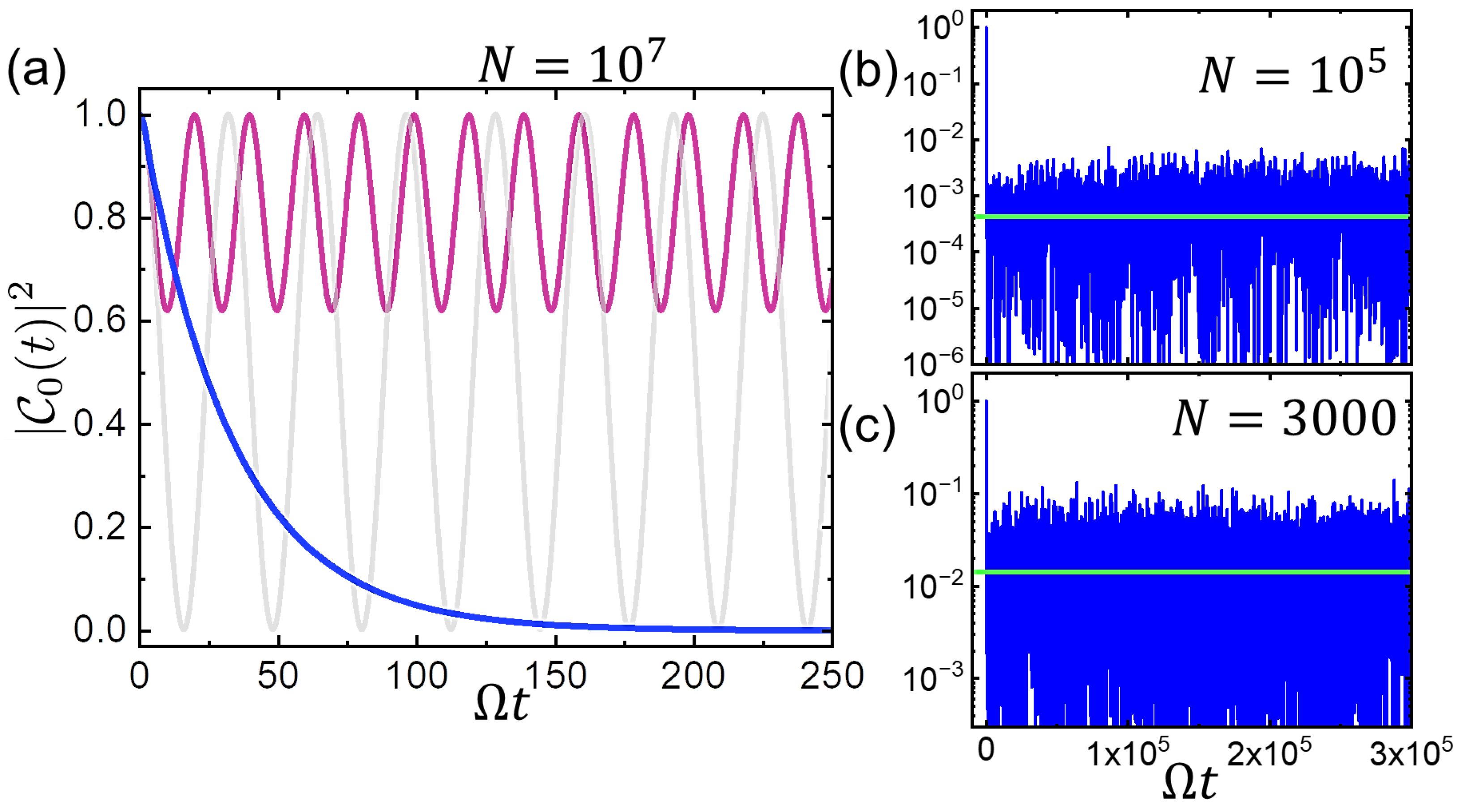Heat Bath in a Quantum Circuit
Abstract
:1. Introduction
2. Basic Properties of Resonators and Josephson Arrays
3. Resonators and Josephson Arrays as Environment: Model
4. Results on the Qubit + Resonator Environment Dynamics
5. Heat Bath Formed of Two-Level Systems (Qubits)
6. Summary
Author Contributions
Funding
Data Availability Statement
Acknowledgments
Conflicts of Interest
References
- Mori, T.; Ikeda, T.N.; Kaminishi, E.; Ueda, M. Thermalization and prethermalization in isolated quantum systems: A theoretical overview. J. Phys. B At. Mol. Opt. Phys. 2018, 51, 112001. [Google Scholar] [CrossRef]
- Nandkishore, R.; Huse, D.A. Many-Body Localization and Thermalization in Quantum Statistical Mechanics. Annu. Rev. Condens. Matter Phys. 2015, 6, 15. [Google Scholar] [CrossRef]
- Zwanzig, R. Nonequilibrium Statistical Mechanics; Oxford University Press: Oxford, UK, 2001. [Google Scholar]
- Reimann, P. Typical fast thermalization processes in closed many-body systems. Nat. Commun. 2016, 7, 10821. [Google Scholar] [CrossRef] [PubMed]
- D’Alessio, L.; Kafri, Y.; Polkovnikov, A.; Rigol, M. From quantum chaos and eigenstate thermalization to statistical mechanics and thermodynamics. Adv. Phys. 2016, 65, 239. [Google Scholar] [CrossRef]
- Popescu, S.; Short, A.; Winter, A. Entanglement and the foundations of statistical mechanics. Nat. Phys. 2006, 2, 754. [Google Scholar] [CrossRef]
- Rigol, M.; Dunjko, V.; Yurovsky, V.; Olshanii, M. Relaxation in a Completely Integrable Many-Body Quantum System: An Ab Initio Study of the Dynamics of the Highly Excited States of 1D Lattice Hard-Core Bosons. Phys. Rev. Lett. 2007, 98, 050405. [Google Scholar] [CrossRef] [PubMed]
- Chen, F.; Sun, Z.; Gong, M.; Zhu, Q.; Zhang, Y.; Wu, Y.; Ye, Y.; Zha, C.; Li, S.; Guo, S.; et al. Observation of Strong and Weak Thermalization in a Superconducting Quantum Processor. Phys. Rev. Lett. 2021, 127, 020602. [Google Scholar] [CrossRef] [PubMed]
- Kuzmin, L.S.; Haviland, D.B. Observation of the Bloch oscillations in an ultrasmall Josephson junction. Phys. Rev. Lett. 1991, 67, 2890. [Google Scholar] [CrossRef] [PubMed]
- Yagi, R.; Kobayashi, S.-I.; Ootuka, Y. Phase Diagram for Superconductor-Insulator Transition in Single Small Josephson Junctions with Shunt Resistor. J. Phys. Soc. Jpn. 1997, 66, 3722. [Google Scholar] [CrossRef]
- Lotkhov, S.V.; Bogoslovsky, S.A.; Zorin, A.B.; Niemeyer, J. Cooper Pair Cotunneling in Single Charge Transistors with Dissipative Electromagnetic Environment. Phys. Rev. Lett. 2003, 91, 197002. [Google Scholar] [CrossRef]
- Pekola, J.P. Towards quantum thermodynamics in electronic circuits. Nat. Phys. 2015, 11, 118. [Google Scholar] [CrossRef]
- Cattaneo, M.; Paraoanu, G.S. Engineering Dissipation with Resistive Elements in Circuit Quantum Electrodynamics. Adv. Quantum Tech. 2021, 4, 2100054. [Google Scholar] [CrossRef]
- Shaikhaidarov, R.S.; Kim, K.H.; Dunstan, J.W.; Antonov, I.V.; Linzen, S.; Ziegler, M.; Golubev, D.S.; Antonov, V.N.; Il’ichev, E.V.; Astafiev, O.V. Quantized current steps due to the a.c. coherent quantum phase-slip effect. Nature 2022, 608, 45. [Google Scholar] [CrossRef] [PubMed]
- Subero, D.; Maillet, O.; Golubev, D.S.; Thomas, G.; Peltonen, J.T.; Karimi, B.; Marín-Suárez, M.; Yeyati, A.L.; Sánchez, R.; Park, S. Bolometric detection of coherent Josephson coupling in a highly dissipative environment. arXiv 2023, arXiv:2210.14953. [Google Scholar]
- Corlevi, S.; Guichard, W.; Hekking, F.W.J.; Haviland, D.B. Phase-Charge Duality of a Josephson Junction in a Fluctuating Electromagnetic Environment. Phys. Rev. Lett. 2006, 97, 096802. [Google Scholar] [CrossRef] [PubMed]
- Jones, P.J.; Huhtamäki, J.A.M.; Salmilehto, J.; Tan, K.Y.; Möttönen, M. Tunable electromagnetic environment for superconducting quantum bits. Sci. Rep. 2013, 3, 1987. [Google Scholar] [CrossRef] [PubMed]
- Masluk, N.A.; Pop, I.M.; Kamal, A.; Minev, Z.K.; Devoret, M.H. Microwave Characterization of Josephson Junction Arrays: Implementing a Low Loss Superinductance. Phys. Rev. Lett. 2012, 109, 137002. [Google Scholar] [CrossRef] [PubMed]
- Pop, I.M.; Geerlings, K.; Catelani, G.; Schoelkopf, R.J.; Glazman, L.I.; Devoret, M.H. Coherent suppression of electromagnetic dissipation due to superconducting quasiparticles. Nature 2014, 508, 369. [Google Scholar] [CrossRef] [PubMed]
- Rastelli, G.; Pop, I.M. Tunable ohmic environment using Josephson junction chains. Phys. Rev. B 2018, 97, 205429. [Google Scholar] [CrossRef]
- Kuzmin, R.; Mehta, N.; Grabon, N.; Mencia, R.; Manucharyan, V.E. Superstrong coupling in circuit quantum electrodynamics. Npj Quantum Inf. 2019, 5, 20. [Google Scholar] [CrossRef]
- Léger, S.; Puertas-Martínez, J.; Bharadwaj, K.; Dassonneville, R.; Delaforce, J.; Foroughi, F.; Milchakov, V.; Planat, L.; Buisson, O.; Naud, C.; et al. Observation of quantum many-body effects due to zero point fluctuations in superconducting circuits. Nat. Commun. 2019, 10, 5259. [Google Scholar] [CrossRef]
- Scigliuzzo, M.; Bengtsson, A.; Besse, J.; Wallraff, A.; Delsing, P.; Gasparinetti, S. Primary Thermometry of Propagating Microwaves in the Quantum Regime. Phys. Rev. X 2020, 10, 041054. [Google Scholar] [CrossRef]
- Kuzmin, R.; Mehta, N.; Grabon, N.; Mencia, R.A.; Burshtein, A.; Goldstein, M.; Manucharyan, V.E. Observation of the Schmid-Bulgadaev dissipative quantum phase transition. arXiv 2023, arXiv:2304.05806. [Google Scholar]
- Giazotto, F.; Heikkilä, T.T.; Luukanen, A.; Savin, A.M.; Pekola, J.P. Opportunities for mesoscopics in thermometry and refrigeration: Physics and applications. Rev. Mod. Phys. 2006, 78, 217. [Google Scholar] [CrossRef]
- Stockklauser, A.; Scarlino, P.; Koski, J.; Gasparinetti, S.; Andersen, C.K.; Reichl, C.; Wegscheider, W.; Ihn, T.; Ensslin, K.; Wallraff, A. Strong Coupling Cavity QED with Gate-Defined Double Quantum Dots Enabled by a High Impedance Resonator. Phys. Rev. X 2017, 7, 011030. [Google Scholar] [CrossRef]
- A-Arriola, P.; Wollack, E.A.; Pechal, M.; Witmer, J.D.; Hill, J.T.; Safavi-Naeini, A.H. Coupling a Superconducting Quantum Circuit to a Phononic Crystal Defect Cavity. Phys. Rev. X 2018, 8, 031007. [Google Scholar]
- Zhong, Y.P.; Chang, H.-S.; Satzinger, K.J.; Chou, M.-H.; Bienfait, A.; Conner, C.R.; Dumur, É.; Grebel, J.; Peairs, G.A.; Povey, R.G.; et al. Violating Bell’s inequality with remotely connected superconducting qubits. Nat. Phys. 2019, 15, 741. [Google Scholar] [CrossRef]
- Caldeira, A.O.; Leggett, A.J. Quantum Tunnelling in a Dissipative System. Ann. Phys. 1983, 149, 374. [Google Scholar] [CrossRef]
- Leggett, A.J.; Chakravarty, S.; Dorsey, A.T.; Fisher, M.P.A.; Garg, A.; Zwerger, W. Dynamics of the dissipative two-state system. Rev. Mod. Phys. 1987, 59, 1. [Google Scholar] [CrossRef]
- Pekola, J.P.; Karimi, B. Ultrasensitive Calorimetric Detection of Single Photons from Qubit Decay. Phys. Rev. X 2022, 12, 011026. [Google Scholar] [CrossRef]
- Gardiner, C.W.; Collett, M.J. Input and output in damped quantum systems: Quantum stochastic differential equations and the master equation. Phys. Rev. A 1985, 31, 3761. [Google Scholar] [CrossRef] [PubMed]
- Gardiner, C.W.; Zoller, P. Quantum Noise. In A Handbook of Markovian and Non-Markovian Quantum Stochastic Methods with Applications to Quantum Optics, 3rd ed.; Springer: Berlin/Heidelberg, Germany, 2010. [Google Scholar]
- Kjaergaard, M.; Schwartz, M.E.; Braumüller, J.; Krantz, P.; Wang, J.I.-J.; Gustavsson, S.; Oliver, W.D. Superconducting Qubits: Current State of Play. Annu. Rev. Condens. Matter Phys. 2020, 11, 369. [Google Scholar] [CrossRef]
- Spiecker, M.; Paluch, P.; Gosling, N.; Drucker, N.; Matityahu, S.; Gusenkova, D.; Günzler, S.; Rieger, D.; Takmakov, I.; Valenti, F.; et al. Two-level system hyperpolarization using a quantum Szilard engine. Nat. Phys. 2023, 19, 1320. [Google Scholar] [CrossRef]
- Karimi, B.; Pekola, J.P. A qubit tames its environment. Nat. Phys. 2023, 19, 1236. [Google Scholar] [CrossRef]
- Pekola, J.P.; Karimi, B.; Cattaneo, M.; Maniscalco, S. Long-Time Relaxation of a Finite Spin Bath Linearly Coupled to a Qubit. Open Syst. Inf. Dyn. 2023, 30, 2350009. [Google Scholar] [CrossRef]
- Bocchieri, P.; Loinger, A. Quantum Recurrence Theorem. Phys. Rev. 1957, 107, 337. [Google Scholar] [CrossRef]
- Chang, H.-S.; Zhong, Y.; Bienfait, A.; Chou, M.-H.; Conner, C.; Dumur, E.; Grebel, J.; Peairs, G.; Povey, R.; Satzinger, K.; et al. Remote Entanglement via Adiabatic Passage Using a Tunably Dissipative Quantum Communication System. Phys. Rev. Lett. 2020, 124, 240502. [Google Scholar] [CrossRef]



Disclaimer/Publisher’s Note: The statements, opinions and data contained in all publications are solely those of the individual author(s) and contributor(s) and not of MDPI and/or the editor(s). MDPI and/or the editor(s) disclaim responsibility for any injury to people or property resulting from any ideas, methods, instructions or products referred to in the content. |
© 2024 by the authors. Licensee MDPI, Basel, Switzerland. This article is an open access article distributed under the terms and conditions of the Creative Commons Attribution (CC BY) license (https://creativecommons.org/licenses/by/4.0/).
Share and Cite
Pekola, J.P.; Karimi, B. Heat Bath in a Quantum Circuit. Entropy 2024, 26, 429. https://doi.org/10.3390/e26050429
Pekola JP, Karimi B. Heat Bath in a Quantum Circuit. Entropy. 2024; 26(5):429. https://doi.org/10.3390/e26050429
Chicago/Turabian StylePekola, Jukka P., and Bayan Karimi. 2024. "Heat Bath in a Quantum Circuit" Entropy 26, no. 5: 429. https://doi.org/10.3390/e26050429





